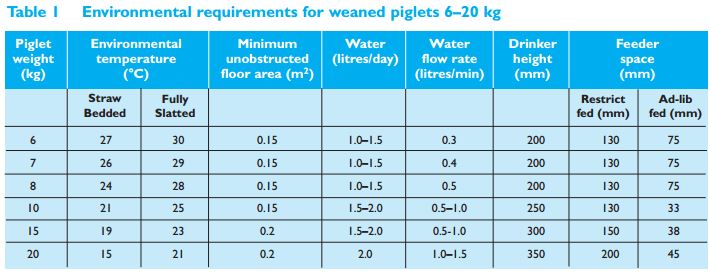



Establishing the Weaner
These guidelines from AHDB Pork should help you to assess the correct conditions for your piglets, and ensure they make it through the challenges of weaning.At weaning the piglet experiences multiple challenges, including: the stress of being taken from the sow, being mixed with other pigs and establishing a new “pecking order”, a new environment, a change of diet and a health challenge.
As a result, daily liveweight gain, which can be around 300 g/day the week prior to weaning (assuming weaning at 28 days), can be reduced by up to 200 g/day.
There is evidence that growth rate during the first few weeks post-weaning is positively correlated with subsequent lifetime performance. It is therefore important to establish the weaner immediately post-weaning to maintain growth rates.
Targets:
- Minimise the challenges faced by piglets at weaning
- Reduce the post-weaning growth check
- Reduce days to sale by up to 20 days
Management guidelines
Pre-weaning
A good weaning weight (eg 7.5 kg at 26 days) is critical. Research has shown that heavier piglets at weaning have better lifetime performance than lighter contemporaries and that weaning weight is a more accurate indication of post-weaning growth than either birth weight or age.
- Optimise gut development, pre-weaning growth and weaning weight through creep feeding
- Feed the lactating sow appropriately for maximum milk yield
Environment
- Unfavourable conditions can severely affect feed intake and increase the risk of disease and growth checks (see Table 1).
- Run weaner accommodation on an all-in-all-out basis. Clean, disinfect and dry between batches.
- Provide warmth: Ensure there is adequate dry bedding, or if using slatted floored pens, heat the house to the correct temperature before introducing piglets
- Avoid temperature fluctuations; check the min/max temperatures at least daily. For temperature recommendations (see Table 1)
- Exclude all draughts and control airflow to prevent chilling but maintain air quality
- Ensure that there is adequate lighting to enable all piglets to find feed and water; ideally fit timers to control the daily pattern of light and dark
- Move and handle piglets calmly, with minimal stress at all times
- Keep mixing to a minimum. Where litters are mixed, sort piglets by size to enable correct feeding and minimise future variation
- Where piglets are weaned at varying ages the younger pigs will be less mature at weaning and less able to adapt to the stresses of weaning
- Control vermin and birds
Environmental conditions and piglet behaviour should be monitored regularly and carefully. For example:
- Lying habits - look out for huddling which may indicate chilling
- Vices - these may indicate draughts, stocking density problems, insufficient access to feed and water etc
- Noise - high levels of noise may be indicative of stress
- Dunging in lying area - could be the result of chilling
Health
- Weaning occurs as the piglet’s passive immunity, derived from the sow, is declining and before the piglet’s own immunity is fully established.
- Minimise health challenges as far as possible (e.g. from the environment or other pigs)
- Promptly identify ‘poor doers’ and sick pigs and treat appropriately
- Review hygiene protocols in relation to the challenges
- Where possible keep sources separate, ideally by site or building, but at least by pen
- Review farm health plans with your herd vet, eg breeding herd vaccination protocols
Food and water
Weaning generally involves a major dietary change - both feed form and temperature. Establishing both feed and water intake as soon as possible after weaning is critical to:
- Re-hydrate the piglets
- Provide a readily available energy source and maintain body temperature
- Promote gut health and stability
- If creep feeding, use the same diet for the first 24-48 hours post-weaning
- Presentation and positioning are critical, fresh feed must be readily visible and accessible
- Store all creep in a cool area to retain palatability
- Initially, provide extra space with additional troughs/ trays to enable all the piglets to feed at the same time
- The piglets have been used to being ‘called’ to feed by the sow. “Call” the piglets to feed 3 or 4 times a day for the first couple of days to ensure that they are all feeding
- Use ad-lib hoppers once piglets are eating well and adjust to maintain intakes but minimise wastage
- Clean feeders daily to minimise fouling – reducing the risk of disease and encourage intake. Ensure hoppers are covered to prevent fouling
- Diet changes should be planned to be appropriate for the stage, growth and appetite of the piglets, in combination with the cost of the diet. Consult your nutritional advisor and feed supplier
- Water must be available at all times and the supply checked at least daily. Consider position, height, different types of drinker, ease of operation and flow rates. Clean the water line (between batches) and drinkers regularly (daily in the event of fouling)
- Provide extra drinkers, with obvious water availability eg bowls or turkey drinkers, to encourage water intake during the first few days
- Monitor feeding and drinking habits – queuing and/or fighting may indicate insufficient access.
September 2015









